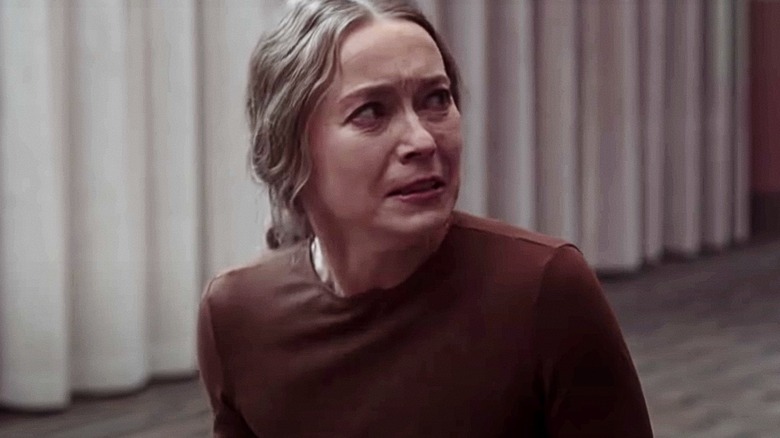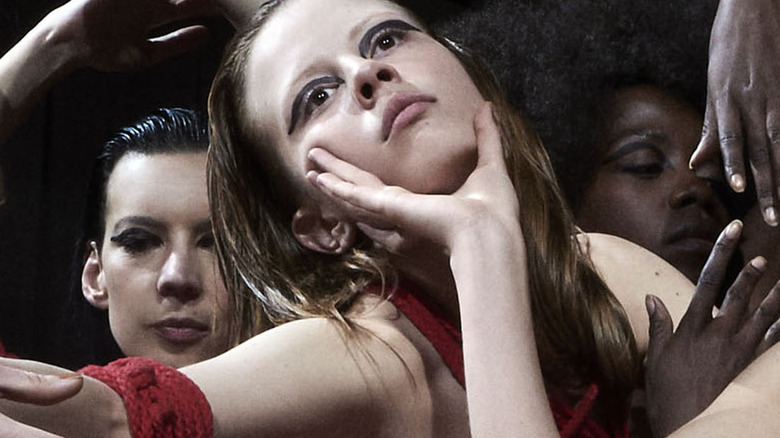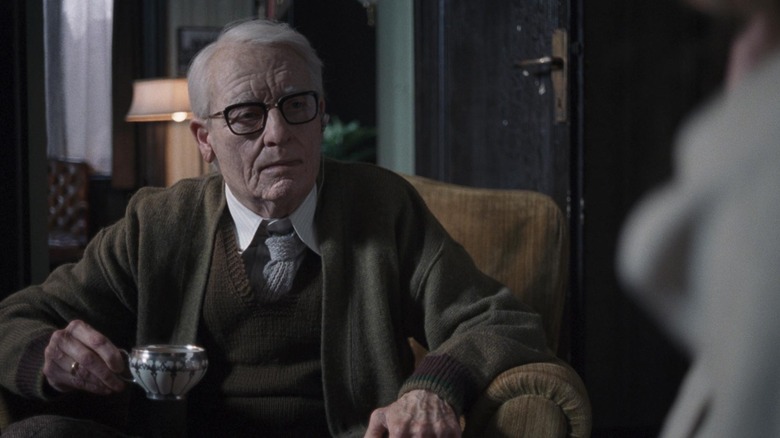How Suspiria Pulled Off Its Most Grotesque Scene
Luca Guadagnino approached the 2018 version of "Suspiria" with the utmost respect. Acknowledging that Dario Argento's 1977 original was a horror classic, Guadagnino was careful to include certain elements from the film — the 1977 setting, the witches, the dance school, the dark conspiracy therein — and tie them into deeper thematic and political themes pertaining to Germany in the 1970s. The Berlin Wall is literally just outside the doors of the Markos Dance Academy, and there are multiple references to the Baader-Meinhof group.
There also appears to have been an effort to make the new "Suspiria" as grotesque as possible. Although Guadagnino hadn't directed a horror film before 2018, he certainly had a knack for blood and mutilation, and several sequences in the film required crushed bones, blood splatter, and flesh rent to shreds.
To briefly editorialize, the 2018 version of "Suspiria" is one of the best of all horror remakes, as it stands as a beautiful work of art unto itself. It is calm and gorgeous yet violent and weird. Tilda Swinton gives several great performances, including that of an elderly man (Swinton was credited as Lutz Ebersdorf for this role). What thematic reasons Guadagnino had for casting Swinton as an elderly man is a matter of artistic debate, although he does seem to be drawing a parallel between mourning death and the monstrous misguidedness of lusting for immortality. Argento's film remains one of the more visually exhilarating horror movies of all time, but Guadagnino's version warrants discussion.
Olga's horrible fate
One of the more notable scenes of violence in "Suspiria" involves a character named Olga (Elena Fokina) who is locked in a mirrored dance studio by witches. In the room above, Susie Bannion (Dakota Johnson) is performing a modern dance routine for her instructor (Tilda Swinton). Susie's hands and feet have been, unbeknownst to her, psychokinetically tied into Olga's body. As Susie dances, Olga is thrown around the room, her arms, legs, torso, and jaw snapping out of place and contorting her into a helpless ball of flesh and blood. The sequence lasts about 10 minutes.
To realize the broken bones and twisted arms, "Suspiria's" makeup team, led by prosthetics artist Mark Coulier, had to sculpt multiple body parts out of a fleshy, soft silicone to make it appear as if Fokina was being twisted like a pretzel. Olga's broken jaw was a prosthetic appliance attached to Fokina's face. The distended stomach and broken ribs were part of a rubber vest that Fokina wore. To realize the broken arm and leg, entire prosthetic limbs were constructed and attached to the actress, with her real limbs covered in green stockings to be digitally erased in post-production. When "suited up," Fokina looked like she had fallen down every staircase in a 100-story building.
The scene is enhanced by the sound effects produced by a very talented foley team. In Hollywood, the sound of broken bones was once captured by breaking sticks, crunching cereal, or twisting stalks of celery. For "Suspiria," it sounds like foley artists used the whole kitchen.
Slicing open stomachs
Mia Goth plays a character named Sara, who ... well, horrible things happen to her throughout "Suspiria." Mark Coulier had to construct multiple torsos out of silicone and fill them with artificial — and in some cases real — organs for bloody removal. Evidently, Guadagnino handed Coulier several medical reference textbooks and pictures of actual cadavers to ensure medical accuracy. Because of what happens to her character, Chloë Grace Moretz had to wear a full-size silicone bodysuit constructed of as many as 20 prosthetic pieces which took five hours to apply. The pieces were then attached to off-screen tubes that pumped in fake blood. There was a lot of fake blood, and several of the effects technicians had to wear protective gear as to not get coated themselves.
The fleshy silicone in "Suspiria" was a material called PlatSil Gel-10, produced by a company called Polytek. PlatSil Gel-10 is, in the words of the manufacturer, a two-part, platinum-catalyzed, liquid silicone system that cures to a milky white. Its consistency and color make it ideal for casting prosthetics and life molds, and it is used in a lot of horror movies. If you, dear reader, wish to make your own prosthetic limbs for horror movie purposes, you can buy two pounds of the stuff for a mere $58.00. An 80-pound kit will run you $1,411.00.
Neck stabbing
In what is a relatively smaller moment of gore, the character of Miss Griffith, played by Sylvie Testud, stabs herself repeatedly in the neck at a dinner table. Achieving this effect required building a thin, false flap of neck flesh that was strapped around Testud's throat with the stab wounds already sculpted into it. Testud would stab where the wounds were (with a safe prop knife, of course), and the blood technicians would pump blood through the cuts.
These sorts of messy effects typically only get a few takes, as cleaning up the blood, resetting the shot, and reapplying the effect takes a great deal of time. Often, when you see practical gore effects in a horror movie, they were probably only done once.
Whatever Gudagnino and his effects team did, however, they did it right. There were reports of dry heaves when some of the gore scenes were previewed at conventions. Practical gore effects tend to look better than their digital counterparts. There is a visceral heft to seeing liquid blood and rubbery flesh onscreen, as opposed to carefully animated arterial spray or squished organs provided by ILM. Guadagnino may not have directed a horror film before, but he proved that he has a knack.
Guadagnino's next film is "Bones & All," and it will be a sequel to his hit 2017 romance film, "Call Me By Your Name" with Timothée Chalamet reprising his role.


